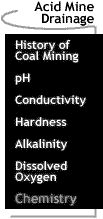

 |
Acid Mine Drainage: Chemistry Acid mine drainage impacts stream and river ecosystems through acidity, ferric ion (Fe3+) precipitation, oxygen depletion, and release of heavy metals associated with coal and metal mining, such as aluminum (Al3+), zinc (Zn2+), and manganese (Mn2+). When mineral deposits that contain sulfides are mined, they have the potential to produce acid mine drainage. This includes the mining of coal, copper, gold, silver, zinc, lead, and uranium. The mineral pyrite, more commonly known as "fool's gold," is iron disulfide (FeS2). Pyrite is one of the most important sulfides found in the waste rock of mines. When exposed to water and oxygen, it can react to form sulfuric acid (H2SO4). The following oxidation and reduction reactions express the breakdown of pyrite that leads to acid mine drainage. 1. 2FeS2 + 7O2 + 2H2O -> 2FeSO4 + 2H2SO4 2. 2Fe2+ + 1/2 O2 + 2H+ -> 2Fe3+ + H2O 3. Fe3+ + 3H2O -> Fe(OH)3 + 3H+ 4. FeS2 (s) + 15/4 O2 + 7/2 H2O <--> 4H+ + 2SO4- +Fe(OH)3 (s) Production of acid mine drainage can occur long after mines have been abandoned if piles of waste rock are in contact with air and water. The red color often seen in streams receiving acid mine drainage is actually a stain on the rocks called "Yellow-Boy," or ferrous hydroxide (Fe(OH)3) formed during Reaction 3 above. Equation 4 shows that by introducing hydrogen ions, acid mine drainage affects the acidity of a stream. Acidity is commonly measured by pH values, which are easy to collect and compare. pH, however, is not always a good indicator of acid mine drainage because it only indicates the concentration of hydrogen ions. When evaluating the extent of acid mine drainage, it is important to know the amount of hydrogen ions remaining in solution after the natural buffering of the stream is completed. For example, pH measurements may not detect heavy acid mine drainage in a stream because of high alkalinity due to dissolved carbonates. Assessing the excess of hydrogen ions over basic ions,"total acidity," is a better measurement of acid mine drainage. Acid mine drainage depletes the buffering ability of water by neutralizing carbonate and bicarbonate ions to form carbonic acid (H2CO3). H+ + CO32- <--> HCO3- H+ + HCO3- <--> H2CO3 Once exposed to acid mine drainage, the affected carbonate buffering system is not able to control changes in pH as well. The buffering system is completely destroyed below a pH of 4.2, where all carbonate and bicarbonate ions are converted to carbonic acid. The carbonic acid readily breaks down into water and carbon dioxide. H2CO3 --> H2O + CO2 Table comparing waters receiving acid mine drainage, acid rain, and peat drainage. Bright orange-colored water and stained rocks are usually tell-tale signs of acid mine drainage. The orange color is caused by ferric hydroxide ( Fe(OH)3 ) precipitating out of the water. The precipitate forms as the acid mine drainage becomes neutralized. At low pH values, the metal ions remain soluble. When the pH rises, the iron oxidizes and precipitates out. Depending on the conditions, the orange-colored precipitates may form inside the mine or several miles downstream. The precipitates can be harmful to aquatic life. The clumps reduce the amount of light that can penetrate the water, affecting photosynthesis and visibility for animal life. Futhermore, when the precipitate settles, it blankets the stream bed, smothering the bottom-dwellers and their food resources. Treatment of mine effluent
The bases used in the treatment of acid mine drainage work by neutralizing the acidity of the mine effluent. Because they are strong bases, they ionize and dissolve in water. The resulting hydroxide (OH-) and carbonate (CO32-) ions combine with hydrogen (H+) ions, taking them out of solution. The resulting products are water (H+ + OH- <-> H2O) and carbonic acid (H2CO3). The carbonic acid is relatively harmless because it is a weak acid and can be dissociated as water and carbon dioxide, as described in the bicarbonate buffering system under alkalinity. Water hardness and conductivity are useful indicators of upstream mining activity. Water hardness may be higher in watersheds with active or abandoned mines. Ferrous iron (Fe2+) from acid generating reactions and calcium (Ca2+) from acid-neutralizing reactions may contribute to higher than average levels of water hardness. Leftover ions from acid-generating and acid-neutralizing reactions can effectively increase the salt concentration, or salinity, of the water. The greater the salt concentration, the greater the conductivity of the water, which makes conductivity a very useful indicator of upstream mining activity. [ Acid
Mine Drainage: History of Coal Mining /
pH /
Conductivity / [ Sewage ] [ Agriculture ] [ Dredging ] [ Home ] [ Teacher Pages ] [ Modules & Activities ] |
HTML code by Chris Kreger
Maintained by ETE Team
Last updated November 10, 2004
Some images © 2004 www.clipart.com
Privacy Statement and Copyright © 1997-2004 by Wheeling Jesuit University/NASA-supported Classroom of the Future. All rights reserved.
Center for Educational Technologies, Circuit Board/Apple graphic logo, and COTF Classroom of the Future logo are registered trademarks of Wheeling Jesuit University.